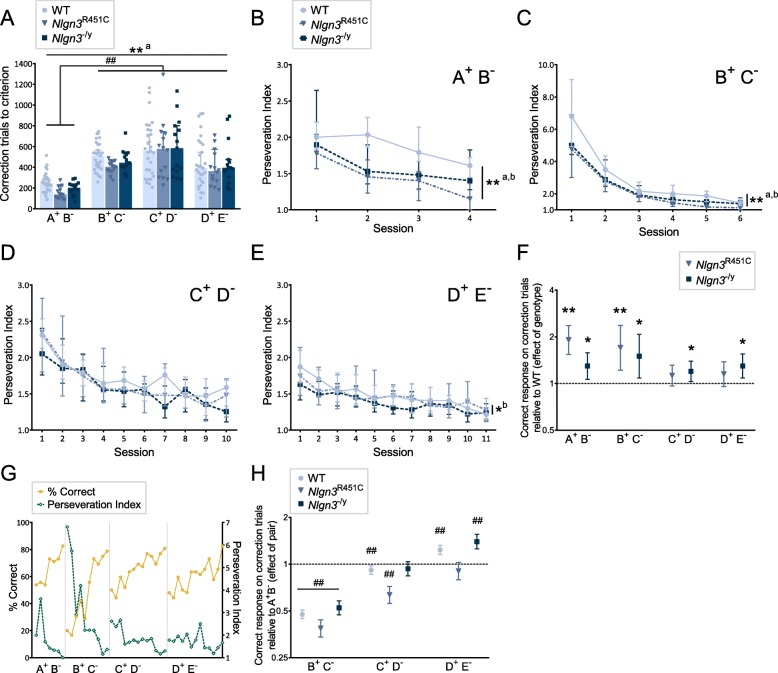Fig. 3.
Nlgn3−/y and Nlgn3R451C mice show altered behavioral flexibility and perseverative behavior. a Total correction trials to criterion during discrimination learning for the 4 premise stimulus pairs (stage 2). Nlgn3R451C: p = 0.024, aMD = − 75, 95%, CI = − 139.88, − 10.13; Nlgn3−/y: p = 0.752, aMD = − 12, 95%, CI = − 86.85, 62.85. Relative to A+B− (B+C−: p < 0.001, aMD = 257, 95%, CI = 217.025, 296.975; C+D−: p < 0.001, aMD = 368, 95% CI = 256.102, 479.899; D+E−: p < 0.001, aMD = 180, 95% CI = 125.529, 234.471. Data presented as medians ± 95% CI. Perseverative index in stage 2 for b A+B−, c B+C−, d C+D−, and D+E−. A+B− (Nlgn3R451C: p < 0.001, aMD = − 0.425, 95% CI = − 0.605, − 0.246; Nlgn3−/y: p = 0.001, aMD = − 0.231, 95% CI = − 0.366, − 0.096). B+C− (Nlgn3R451C: p = 0.001, aMD = − 0.708, 95% CI = − 1.112, − 0.304; Nlgn3−/y: p = 0.010, aMD = − 0.472, 95% CI = − 0.828, − 0.116. D+E− (Nlgn3−/y: p = 0.029, aMD = − 0.097, 95% CI = − 0.184, − 0.009). Data presented as median ± 95% CI. a–e Median regression treating each animal as a cluster, and genotype and session as independent variables. f Effect of genotype on the likelihood of responding correctly to correction trials during stimulus pair learning relative to WT mice (represented by dotted line; 1 = no difference to WT). A+B− (Nlgn3R451C: p < 0.001, OR = 1.909, 95% CI = 1.3542, 2.364; Nlgn3−/y: p = 0.010, OR = 1.296, 95% CI = 1.064, 1.578). B+C− (Nlgn3R451C: p = 0.002, OR = 1.701, 95% CI = 1.220, 2.371; Nlgn3−/y: p = 0.014, OR = 1.500, 95% CI = 1.085, 2.074). C+D− (Nlgn3−/y: p = 0.020, OR = 1.197, 95% CI = 1.029, 1.393). D+E− (Nlgn3−/y: p = 0.004, OR = 1.298, 95% CI = 1.086, 1.551). g Representative plot of % correct response (grey points plotted on left Y axis) and perseveration index (black dotted points plotted on right Y axis) for every session for each premise pair (stage 2). Data represent raw values from one WT mouse. h Effect of pair on the likelihood of responding correctly to correction trials relative to A+B− during premise pair learning (represented by dotted line, 1 = no difference to pair A+B−). See Additional file 1: Table S5 for statistics. f–h Data presented as odds ratio ± 95% CI, logistic regression with individual animals as random effects and session as independent variable. # denotes significant difference between stimulus pairs (#p < 0.05; ##p < 0.01). * denotes significant difference between genotypes (*p < 0.05, **p < 0.01). a = Nlgn3R451C significantly different to WT, b = Nlgn3−/y significantly different to WT

